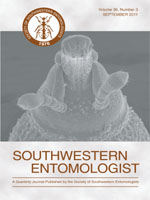In all bioassays in the laboratory, the mortality of neonate beet armyworm, Spodoptera exigua (Hübner); cabbage looper, Trichoplusia ni (Hübner); bollworm, Helicoverpa zea (Boddie); and fall armyworm, Spodoptera frugiperda (J. E. Smith); were greater on dual-Bt (Bollgard II) varieties (average 85.4%) than on single-Bt (Bollgard) cotton (average 45.3%). Bollworm was the most susceptible to Bollgard (average mortality 68.8%), while mortality of beet armyworm was 35.2%, cabbage looper 50.4%, and fall armyworm 49.7%. Mortality of beet armyworm after feeding on Bollgard II and WideStrike Bt traits was 74.1%, and significantly less than of cabbage looper (95.5%), bollworm (90.4%), or fall armyworm (87.2%). Assessing the efficacy of transgenic plants under new environmental and management regimes is of prime importance to the companies that produce new or improve existing transgenic products; plant breeders who create different varieties stacked with Bt endotoxins; and farmers who grow them. For 2006–2009, we did thousands of laboratory bioassays from different Bt trait varieties of cotton. But in the process of investigations, we observed variable data with some of the same treatments and the same initial insects. These reduced accuracy of results and interpretation. Laboratory and field performance of cotton, Gossypium hirsutum L., containing endotoxins should be standardized. Only this can provide accurate and stable data for insect control with different transgenic technology. We discuss approaches and criteria for mass rearing standardized laboratory colonies of beet armyworm, fall armyworm, and bollworm, for laboratory and field evaluation of efficacy of Bt cottons.
BioOne.org will be down briefly for maintenance on 14 May 2025 between 18:00-22:00 Pacific Time US. We apologize for any inconvenience.
How to translate text using browser tools
1 September 2011
Approaches for Improving Present Laboratory and Field Methodology for Evaluation Efficacy of Transgenic Technologies
S. M. Greenberg,
J. J. Adamczyk,
J. J. Alejandro,
J. W. Holloway
ACCESS THE FULL ARTICLE

Southwestern Entomologist
Vol. 36 • No. 3
September 2011
Vol. 36 • No. 3
September 2011




